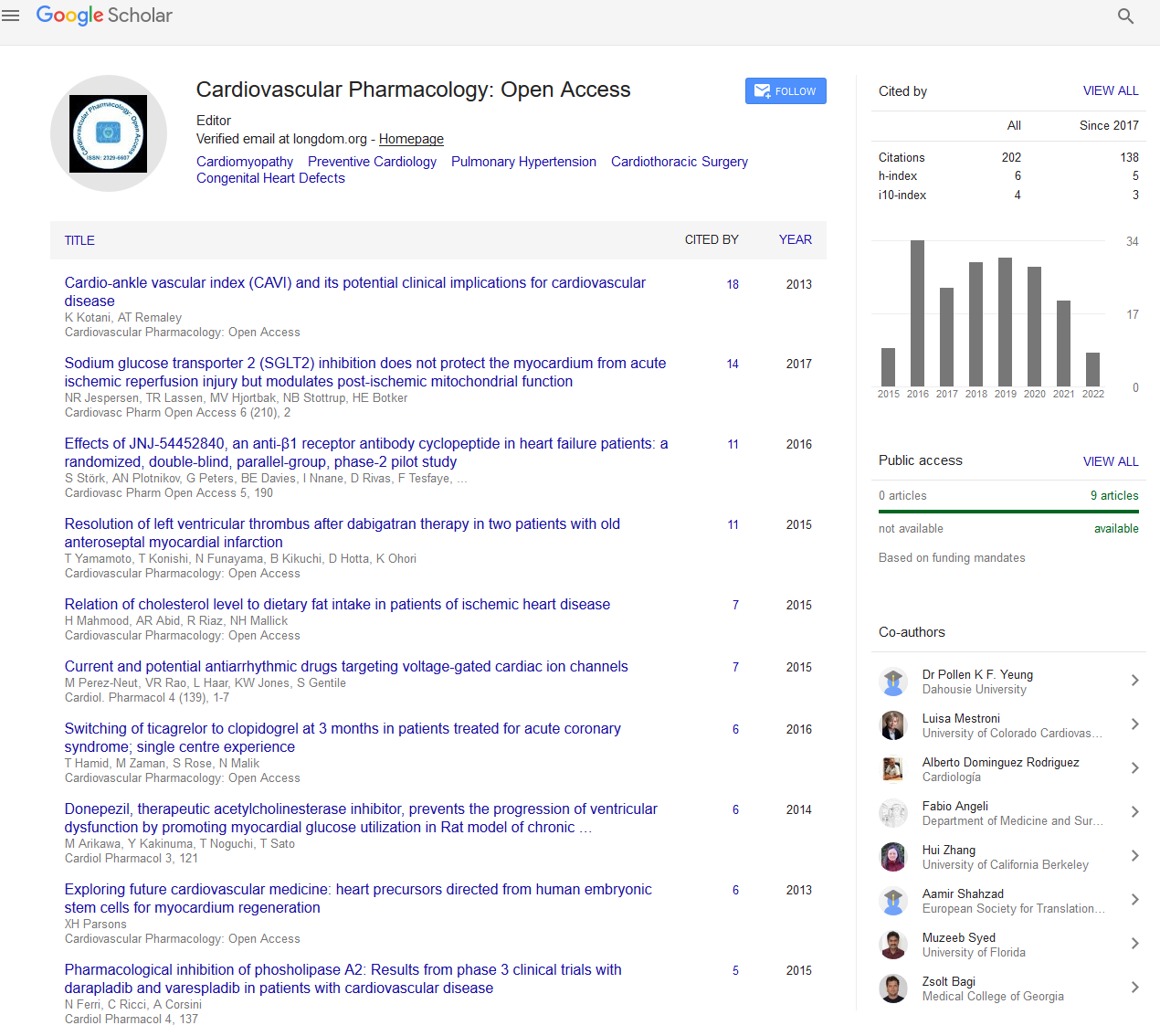Indexed In
- Open J Gate
- Cosmos IF
- RefSeek
- Hamdard University
- EBSCO A-Z
- OCLC- WorldCat
- Publons
- Geneva Foundation for Medical Education and Research
- Euro Pub
- Google Scholar
Useful Links
Share This Page
Journal Flyer

Open Access Journals
- Agri and Aquaculture
- Biochemistry
- Bioinformatics & Systems Biology
- Business & Management
- Chemistry
- Clinical Sciences
- Engineering
- Food & Nutrition
- General Science
- Genetics & Molecular Biology
- Immunology & Microbiology
- Medical Sciences
- Neuroscience & Psychology
- Nursing & Health Care
- Pharmaceutical Sciences
Opinion - (2023) Volume 12, Issue 3
Myocardial Vascular Disease Management Together with Advancement
Philippe Vandervoort*Received: 02-May-2023, Manuscript No. CPO-23-21398; Editor assigned: 05-May-2023, Pre QC No. CPO-23-21398(PQ); Reviewed: 19-Jun-2023, QC No. CPO-23-21398; Revised: 26-May-2023, Manuscript No. CPO-23-21398(R); Published: 02-Jun-2023, DOI: 10.35248/2329-6607.23.12.344
Description
Patients with Coronary Artery Disease (CAD) have a higher risk of syncope due to myocardial ischemia. Acute coronary syndrome, vasospastic angina, exertion angina, and previous myocardial infarction are CAD conditions that can cause syncopal attacks. Pump failure, tachyarrhythmia, bradycardia (including sinus arrest and atrioventricular block), and vagal stimulation are among the potential causes of syncope in coronary artery disease patients. Patients with coronary artery disease have a higher risk of syncope due to myocardial ischemia. Acute coronary syndrome, vasospastic angina, exertion angina, and previous myocardial infarction are coronary artery diseases that can result in syncopal attacks. Pump failure, tachyarrhythmia, bradycardia (including sinus arrest and atrioventricular block), and vagal stimulation are among the potential causes of syncope in CAD patients.
Acute coronary syndrome, vasospastic angina, exertion angina, and previous myocardial infarction are some of the coronary artery disorders that can cause a syncopal episode. Pump failure, tachyarrhythmia, bradycardia, and vagal stimulation are thought to be the probable processes that cause syncope in people with CAD. In Japan, individuals with unexplained syncope may occasionally experience coronary artery spasm in particular. The most dangerous side effects of a coronary spasm-induced ischemia event are life-threatening arrhythmias, which raise the possibility of syncope and/or Sudden Cardiac Death (SCD). To prevent the danger of SCD as a result of syncope caused by the deadly arrhythmia, the diagnosis of Vasospastic Angina (VSA) must be determined immediately during the initial assessment of unexplained syncope. Risk factors for ventricular arrhythmias during coronary spasm include the ability to induce polymorphic ventricular tachycardia or ventricular fibrillation, increased QT dispersion, T-wave alternans, and early repolarization during the asymptomatic phase. According to the findings of multiple studies, implanted Cardioverter/defibrillator therapy should be taken into consideration for patients who, despite receiving adequate medical treatment, are at a high risk of experiencing a deadly ventricular arrhythmia that causes syncope again. This arrhythmia is caused by coronary spasm. The term "vasospastic angina" is now more often used as coronary artery spasm has been demonstrated to be related with either ST elevations or depressions. It is challenging to determine the prevalence of vasospastic angina since provocative spasm testing is rarely used in modern cardiology. As a result, patient selection bias affects prevalence estimates for diagnosing vasospastic angina. However, people in Japan who experience unexplained syncope may occasionally experience coronary artery spasm. Coronary vasospasm, which is unrelated to exercise or effort, is largely characterised by brief and reversible vasoconstriction of the main epicardial coronary arteries that results in myocardial ischemia. Acute coronary syndrome, effort-induced angina, syncope, and sudden cardiac death with life-threatening arrhythmias or conduction abnormalities are only a few clinical manifestations of coronary vasospasm. Vasospastic Angina (VSA) is the temporary blockage of the epicardial coronary arteries. It often happens at night or in the early morning hours and is not accompanied by an elevated need for myocardial oxygen. Vasospastic angina with syncope is a rare but important phenomenon that has to be thoroughly examined. 5% to 15% of individuals with vasospastic angina experience life-threatening ventricular arrhythmias. An increased frequency of cardiac events, including sudden death, is linked to certain arrhythmias. However, in individuals with vasospastic angina, the risk factors for malignant ventricular arrhythmias have not been established.
Acute pulmonary edoema, cardiogenic shock, ventricular fibrillation, and multiple sites of myocardial ischemia can all accompany spontaneous and simultaneous multivessel coronary artery spasm. The underlying mechanism in a case of syncope brought on by vasospasm may be complicated and include atrioventricular block and/or ventricular arrhythmia. Along with receiving the best medical care, the insertion of two Implanted Cardioverter Defibrillators (ICDs) should be taken into account. Patients who have received heart transplantation are more likely to experience the cardiac arrhythmias on a secular trend upward. Arrhythmia continues to be linked to poorer in-hospital outcomes of cardiogenic shock and the use of multiple chemical sensitivity, despite the fact that overall mortality is declining.
Citation: Vandervoort P (2023) Myocardial Vascular Disease Management Together with Advancement. Cardiovasc Pharm. 12:344.
Copyright: © 2023 Vandervoort P. This is an open-access article distributed under the terms of the Creative Commons Attribution License, which permits unrestricted use, distribution, and reproduction in any medium, provided the original author and source are credited.


